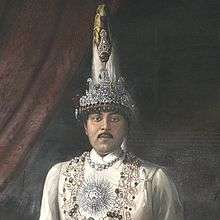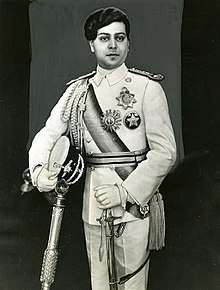Tribhuvan of Nepal
Tribhuwan Bir Bikram Shah (Nepali: त्रिभुवन वीर विक्रम शाह; 30 June 1906 – 13 March 1955) was King of Nepal from 11 December 1911 until his death. Born in Kathmandu, the capital city of Nepal, he ascended to the throne at the age of five, upon the death of his father, King Prithvi Bir Bikram Shah, and crowned on 20 February 1913 at the Nasal Chowk, Hanuman Dhoka Palace in Kathmandu, with his mother acting as regent. At the time, however, the position of monarch was mainly titular, with real power in the country residing in the powerful, conservative Rana family, which supplied the country with its hereditary prime minister. The Rana period is known for the tyranny, debauchery, economic exploitation and religious persecution by the rulers.[1][2]
| Tribhuvan Bir Bikram Shah | |||||
|---|---|---|---|---|---|
 | |||||
| King of Nepal | |||||
| Coronation | 20 February 1913 | ||||
| Reign | 12 December 1911 – 13 March 1955 | ||||
| Predecessor | Prithvi Bikram | ||||
| Successor | Mahendra | ||||
| Born | 30 June 1906 Kathmandu, Nepal | ||||
| Died | 13 March 1955 (aged 48) Canton Hospital, Zürich, Switzerland | ||||
| Spouse | Kanti Rajya Lakshmi Devi Shah Ishwari Rajya Lakshmi Devi Shah | ||||
| Issue (among others) | Mahendra of Nepal Prince Himalaya Prince Basundhara Princess Trilokya Princess Nalini Princess Vijaya Princess Bharati | ||||
| |||||
| Dynasty | Shah dynasty | ||||
| Father | Prithvi Bir Bikram Shah | ||||
| Mother | Divyeshwari Lakshmi Devi Shah | ||||
| Religion | Hindu | ||||
Family
King Tribhuvan was born on 30 June 1906 to Prithvi Bir Bikram Shah and Queen Divyeshwari Lakshmi Devi Shah. After the death of his father, Tribhuvan Bir Bikram Shah ascended the throne on 11 December 1911, at the age of five. Queen Mother Divyeshwari Lakshmi Devi was appointed the regent until King Tribhuvan would come to his age. In a double ceremony, he married first at the Narayanhity Royal Palace, Kathmandu, March 1919, H.M. Svasti Sri Ojaswi Rajanya Sri Sri Sri Sri Sri Sriman Maharajadhiraja Patta Rajninam Bada Maharani Kanti Rajya Lakshmi Devi Shahanam Sada Saubhajnabatinam (H.M. Queen Kanti).[3] The same day he also married her sister, H.M. Svasti Sri Ojawsi-Rajanya Sri Sri Sri Sri Sri Sriman Maharajadhiraja Patta Rajninam Kancha Maharani Ishwari Rajya Lakshmi Devi Shahanam Sada Saubhajnabatinam (H.M. Queen Ishwari). Both were full sisters (in an arranged custom in their young age). He also had junior wives.
King Tribhuvan had three sons and thirteen daughters. The sons include:
- H.M. Mahendra Bir Bikram Shah, King of Nepal (by Queen Kanti) born in 1920.
- H.R.H. Prince Himalaya Pratap Bir Bikram Shah, GCMG, GBE (by Queen Kanti) born in 1921.
- H.R.H. Prince Basundhara Bir Bikram Shah, GCMG (by Queen Ishwari) born in 1921.
The daughters include:
- H.R.H. Princess Trilokya Rajya Lakshmi Devi (by Queen Kanti) born in 1923.
- H.R.H. Princess Nalini Rajya Lakshmi Devi (H.R.H. the Rani Sahiba of Poonch) (by Queen Ishwari) born in 1925.
- H.R.H. Princess Vijaya Rajya Lakshmi Devi (by Queen Kanti) born in 1925.
- H.R.H. Princess Bharati Rajya Lakshmi Devi (H.R.H. the Rajmata of Mayurbhanj) (by Queen Kanti) born in 1927.
Children of junior wives include:
- Rajkumari Rajya Lakshmi Devi.
- Rajkumari Divyeshwari Rajya Lakshmi Devi (Dibya Shree Malla).
- Rajkumari Praja Rajya Lakshmi Devi.
- Rajkumari Achala Rajya Lakshmi Devi.
- Rajkumari Tika Rajya Lakshmi Devi.
- Rajkumari Bimala Rajya Lakshmi Devi.
Three unnamed daughters of King Tribhuvan perished during the Great earthquake, at the Narayanhity Royal Palace, Kathmandu, 15 January 1934.
Later life
Tensions between the royal family and the Ranas came to a head during World War I. The Ranas wanted to join the war in support of Britain, which controlled India to the south. The prime minister, HH Maharaja Sri Chandra Shamsher Jang Bahadur Rana always had his way with the young king, who eventually ordered the troops to go to war.
By the mid-1930s, popular discontent with the Ranas led to the establishment of several movements, notably the Nepal Praja Parishad, to which Tribhuvan himself gave explicit support, to overthrow the Ranas. In each instance, however, the Ranas responded harshly, banning the liberal movements and executing their leadership.

King Tribhuvan worked closely with Praja Parishad to abolish the Rana regime. In November 1950, King Tribhuvan took refuge at the Indian Embassy in a campaign aimed at removing the Rana oligarchy from power, which had ruled Nepal for more than a century. He was accompanied by his son Mahendra and the eldest grandson Birendra, among others. Prime Minister Sir Tin Maharaja, Mohan Shamsher Jang Bahadur Rana became furious and responded to Tribhuvan's move by calling an emergency meeting of the cabinet on 7 November 1950 at Singha Durbar. In that meeting he announced Gyanendra Bir Bikram Shah, the four-year-old grandson of King Tribhuvan as the new King of Nepal. In the afternoon, on the same day, Prince Gyandendra Bir Bikram Shah was brought to Hanuman Dhoka Palace and crowned as the king of Nepal. On 10 November, two Indian planes landed at Gauchar Airport (now called Tribhuvan International Airport) and flew back to New Delhi with the Royal family excluding the infant King, Gyanendra. King Tribhuvan was formally welcomed by the Indian prime minister Jawahar Lal Nehru and other high officials. The removal of the king led to huge demonstrations in the country that compelled the Rana prime minister, Mohan Shamsher Jang Bahadur Rana to come into negotiations with Tribhuvan and the Nepali Congress. On 22 November 1950, Jawahar Lal Nehru, the Prime Minister of India, officially announced that India was not going to recognize Gyanendra Bir Bikram Shah as the legitimate King of Nepal. When Mohan Shumsher saw that the situation was out of his control, he sent the king's brother-in-law, Sir Kaiser Shamsher Jang Bahadur Rana and Bijaya Shamsher Jang Bahadur Rana to New Delhi for peace talks. In New Delhi, King Tribhuvan, representatives of Nepali Congress and of the Rana Government all sat together to discuss the situation. At last an agreement was reached according to which King Tribhuvan to form a new ministry, under his leadership, consisting of the Nepali Congress and the Ranas on an equal basis, King Tribhuvan flew back to Nepal, along with the members of the Royal family and the leaders of the Congress Party on 15 February 1951. On 18 February 1951, King Tribhuvan returned from India as the monarch. Three days after the return, Tribhuvan formally declared an end to Rana's family rule and established a democratic system, but Mohan Shamsher continued as a prime minister for a few more months.
Congress Rana Government
According to the New Delhi Agreement, King Tribhuvan announced on 13 February 1951, a cabinet headed by Sir Mohan Shamsher Jang Bahadur Rana. The following were the members of the Cabinet.
From the Rana clan:
- Sir Mohan Shamsher – Prime minister and Foreign Affairs.
- Sir Baber Shamsher Jang Bahadur Rana- (younger brother of Mohan Shamsher; was in line for the next premiership) – Defence.
- Chudraj Shamsher – ("B" class Rana representative) – Forests.
- Nripa Janga Rana – ("C" class Rana representative) – Education.
- Yagya Bahadur Basnyat – (Rana Bhardar) – Health and Local self-government.
From the Nepali Congress side:
- Bishweshwar Prasad Koirala – Home.[4]
- Subarna Shamsher Rana- (even though a Rana, he represented the Nepali Congress) – Finance.
- Ganesh Man Singh – Commerce and Industry
- Bharatmani Sharma – Food and Agriculture
- Bhadrakali Mishra – Transport.[5]
This cabinet was reshuffled on 10 June 1951 to replace Baber Shamsher by Shangha Shamsher and Bharatmani Sharma by Surya Prasad Upadhyaya. This cabinet was dissolved in November 1951 and MP Koirala became the new Prime Minister.[6]
Death
King Tribhuvan died in 1955 in Zürich, Switzerland, under mysterious circumstances. His Majesty the King of Nepal in Zurich in Switzerland where he had gone for treatment. Unfortunately, the treatment has ended in his death. He was succeeded by his eldest legitimate son, Mahendra.
Condolence message Indian Parliament
So, on the passing of His Majesty King Tribhuvan Bir Bikram Shah, the late King, I am sure this House would like to express its sorrow and would like it to be conveyed to his family. Also, at the same time, I am sure this House would like to send its greetings to the new King Mahendra Bir Bikram Shah and wish him all success in the difficult responsibilities and burdens that have come to him. Above all, we would send our good wishes to the people of Nepal in the great adventures in building up their country on a democratic and prosperous basis that they are indulging in. Thereafter. M. Ananthasayanam Ayyangar. the Speaker observed: On behalf of the House, I associate myself with what the Honorable Leader of the House has said. We certainly send our greetings and all best wishes for the new King and for the people of Nepal. As a mark of respect and our sense of sorrow at the demise of the late King, the House will stand in silence for a minute.[7]
The international airport in Kathmandu, Tribhuvan International Airport, the oldest highway in Nepal Tribhuvan Highway, the 2nd oldest association football tournament in Nepal, Tribhuvan Challenge Shield, a city, Tribhuvannagar in Dang valley, and the country's largest university (Tribhuvan University) are named after him.
Honours
- National
- Sovereign of the Order of Ojaswi Rajanya
- Sovereign of the Order of Nepal Taradisha
- Sovereign of the Order of Gorkha Dakshina Bahu
- Sovereign of the Order of Tri Shakti Patta
- Foreign
.svg.png)


Ancestry
He is a descendant of popular personalities such as Maharaja Jang Bahadur Kunwar Ranaji, Kaji Tularam Pande, Sardar Ramakrishna Kunwar and Kaji General Amar Singh Thapa.
| Ancestors of Tribhuvan of Nepal | |||||||||||||||||||||||||||||||||||||||||||||||||||||||||||||||||||||||||||||||||||||||||||||||||||||||||||||||||||||||||||||||||||||||||||||||||||||||||||||||||||||||||||||||||||||||||||||||||||||||||||||||||||||||||||||||||||||||||||||||||||||||||||||||||||||||||||||||||||||||||||||||||||||||||||||||||||||||||||||||||||||||||||||||||||||||||||||||||||||||||||||||||||||||||||||||||||||||||||||||||||||||||||||||||||||||||||||||||||||||||||||||||||||||||||||||||||
|---|---|---|---|---|---|---|---|---|---|---|---|---|---|---|---|---|---|---|---|---|---|---|---|---|---|---|---|---|---|---|---|---|---|---|---|---|---|---|---|---|---|---|---|---|---|---|---|---|---|---|---|---|---|---|---|---|---|---|---|---|---|---|---|---|---|---|---|---|---|---|---|---|---|---|---|---|---|---|---|---|---|---|---|---|---|---|---|---|---|---|---|---|---|---|---|---|---|---|---|---|---|---|---|---|---|---|---|---|---|---|---|---|---|---|---|---|---|---|---|---|---|---|---|---|---|---|---|---|---|---|---|---|---|---|---|---|---|---|---|---|---|---|---|---|---|---|---|---|---|---|---|---|---|---|---|---|---|---|---|---|---|---|---|---|---|---|---|---|---|---|---|---|---|---|---|---|---|---|---|---|---|---|---|---|---|---|---|---|---|---|---|---|---|---|---|---|---|---|---|---|---|---|---|---|---|---|---|---|---|---|---|---|---|---|---|---|---|---|---|---|---|---|---|---|---|---|---|---|---|---|---|---|---|---|---|---|---|---|---|---|---|---|---|---|---|---|---|---|---|---|---|---|---|---|---|---|---|---|---|---|---|---|---|---|---|---|---|---|---|---|---|---|---|---|---|---|---|---|---|---|---|---|---|---|---|---|---|---|---|---|---|---|---|---|---|---|---|---|---|---|---|---|---|---|---|---|---|---|---|---|---|---|---|---|---|---|---|---|---|---|---|---|---|---|---|---|---|---|---|---|---|---|---|---|---|---|---|---|---|---|---|---|---|---|---|---|---|---|---|---|---|---|---|---|---|---|---|---|---|---|---|---|---|---|---|---|---|---|---|---|---|---|---|---|---|---|---|---|---|---|---|---|---|---|---|---|---|---|---|---|---|---|---|---|---|---|---|---|---|---|---|---|---|---|---|---|---|---|---|---|---|---|---|---|---|---|---|---|---|---|---|---|---|---|---|---|---|---|---|---|---|---|---|---|---|---|---|---|---|---|---|---|---|---|---|---|---|---|---|---|---|---|---|---|---|---|---|---|---|---|---|---|---|---|---|---|---|
| |||||||||||||||||||||||||||||||||||||||||||||||||||||||||||||||||||||||||||||||||||||||||||||||||||||||||||||||||||||||||||||||||||||||||||||||||||||||||||||||||||||||||||||||||||||||||||||||||||||||||||||||||||||||||||||||||||||||||||||||||||||||||||||||||||||||||||||||||||||||||||||||||||||||||||||||||||||||||||||||||||||||||||||||||||||||||||||||||||||||||||||||||||||||||||||||||||||||||||||||||||||||||||||||||||||||||||||||||||||||||||||||||||||||||||||||||||
References
| Wikimedia Commons has media related to Tribhuvan of Nepal. |
- Dietrich, Angela (1996). "Buddhist Monks and Rana Rulers: A History of Persecution". Buddhist Himalaya: A Journal of Nagarjuna Institute of Exact Methods. Retrieved 17 September 2013.
- Lal, C. K. (16 February 2001). "The Rana resonance". Nepali Times. Retrieved 17 September 2013.
- King Tribhuvan and Queen Kanti Archived 10 May 2017 at the Wayback Machine
- www.nepalicongress.org. "NepaliCongress.org- Nepali Congress Official website - Political party of Nepal". www.nepalicongress.org. Retrieved 8 September 2018.
- Revolution of 1951
- "Google Groups". groups.google.com. Retrieved 8 September 2018.
- Selected works of Jawaharlal Nehru. Second Series. Page 53
- informatici, Segretariato generale della Presidenza della Repubblica - Servizio sistemi. "Le onorificenze della Repubblica Italiana". www.quirinale.it. Retrieved 8 September 2018.
Tribhuvan of Nepal Born: 30 June 1906 Died: 13 March 1955 | ||
| Regnal titles | ||
|---|---|---|
| Preceded by Prithvi |
King of Nepal 1911–1950 |
Succeeded by Gyanendra |
| Preceded by Gyanendra |
King of Nepal 1951–1955 |
Succeeded by Mahendra |